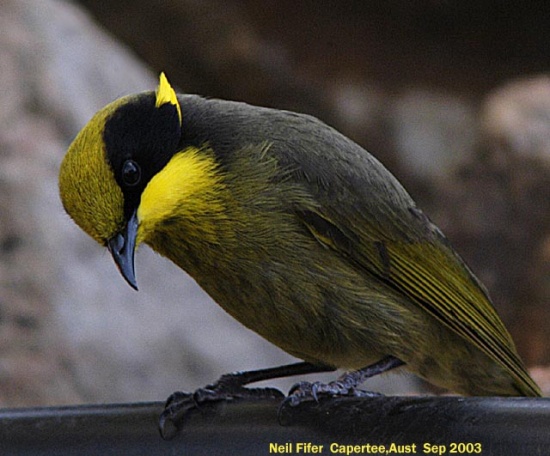- Lichenostomus melanops
Includes: Helmeted Honeyeater
Identification
16·5–21 cm (6½-8¼ in)
- Olive-brown upperparts
- Yellowish-grey underparts
- Black face mask
- Bright yellow ear tufts and sides of the throat
- Down-curved bill
Sexes similar
Young birds are duller and paler, with yellow areas washed green
Distribution
Eastern and south-eastern mainland Australia.
Taxonomy
Subspecies
There are 3 subspecies[1]
- L. m. meltoni:
- Central and eastern Queensland through New South Wales to far south-eastern South Australia
- L. m. melanops:
- Eastern New South Wales (about Lismore to Jervis Bay)
- L. m. cassidix: Helmeted Honeyeater is much larger, with brighter plumage
- South-central Victoria (Yellingbo district of West Gippsland)
Habitat
Open dry sclerophyll forests and woodlands dominated by eucalypts; often near water. They sometimes visit gardens. L. m. cassidix is found in narrow patches of tall forest along streams or in swamps.
Behaviour
Diet
The main diet consists of arthropods (mostly insects with some spiders); occasionally snails. They also eat nectar from eucalypt flowers.
Breeding
They breed in colonies. Pairs are monogamous and the pair are sometimes assisted with feeding and nest cleaning by 'helpers'. They construct a tightly woven, cup-shaped nest. The females do most of the incubation, with both parents, and any helpers, feed the young. Two or three broods may be raised in a season.
References
- Clements, J. F., T. S. Schulenberg, M. J. Iliff, D. Roberson, T. A. Fredericks, B. L. Sullivan, and C. L. Wood. 2018. The eBird/Clements checklist of birds of the world: v2018. Downloaded from http://www.birds.cornell.edu/clementschecklist/download/
- Handbook of the Birds of the World Alive (retrieved July 2018)
- Birds in Backyards
Recommended Citation
- BirdForum Opus contributors. (2025) Yellow-tufted Honeyeater. In: BirdForum, the forum for wild birds and birding. Retrieved 13 February 2025 from https://www.birdforum.net/opus/Yellow-tufted_Honeyeater






